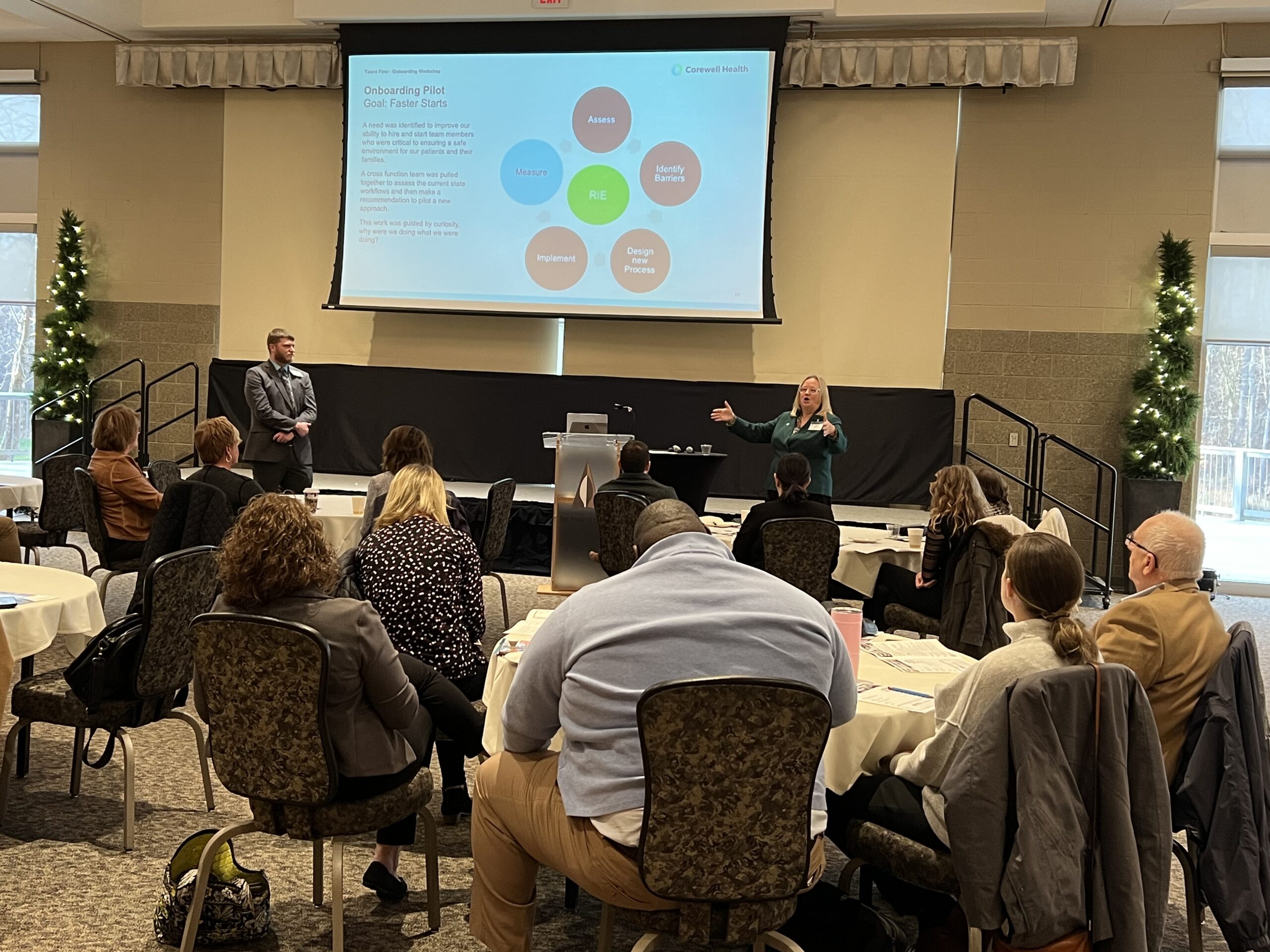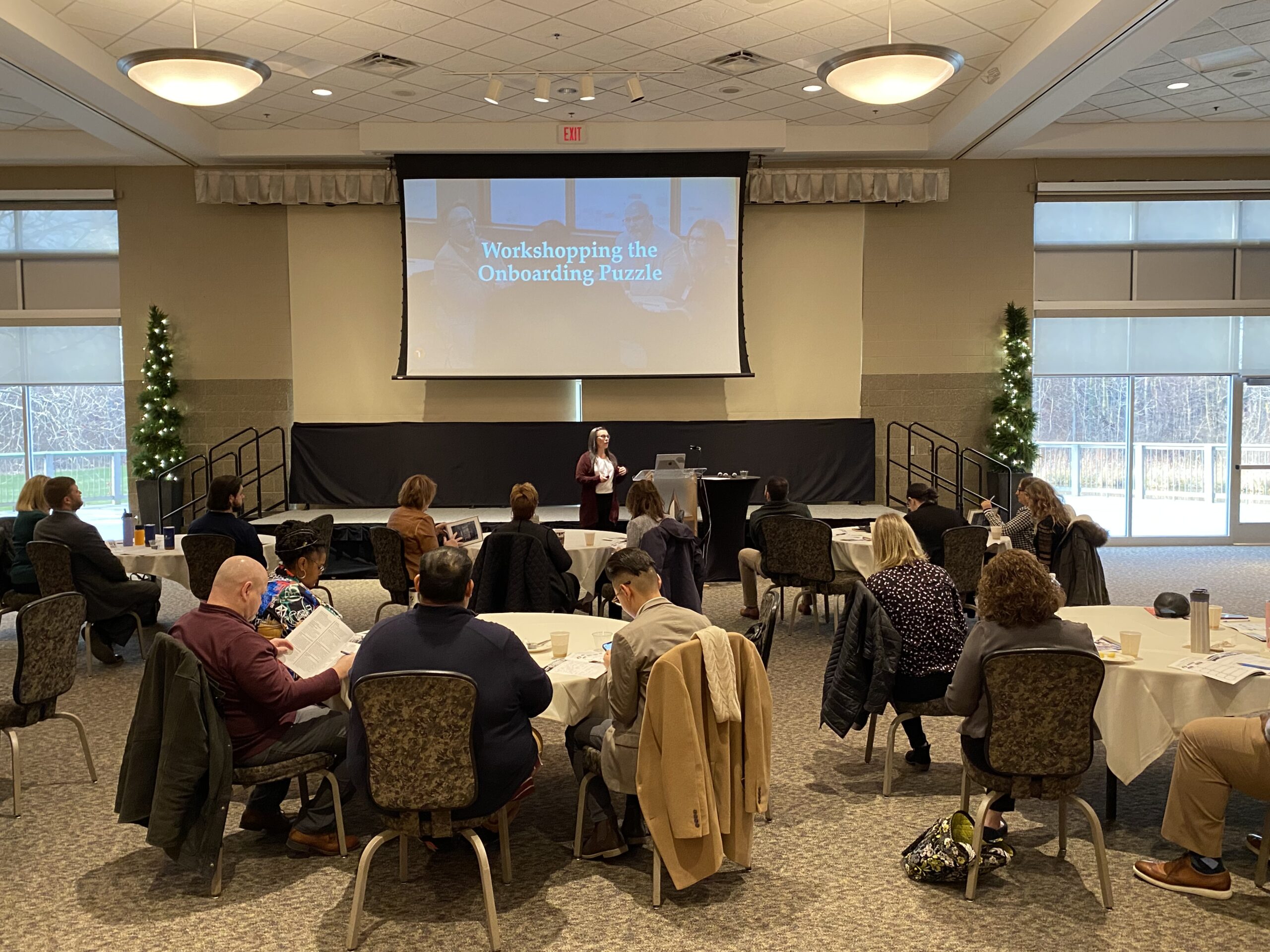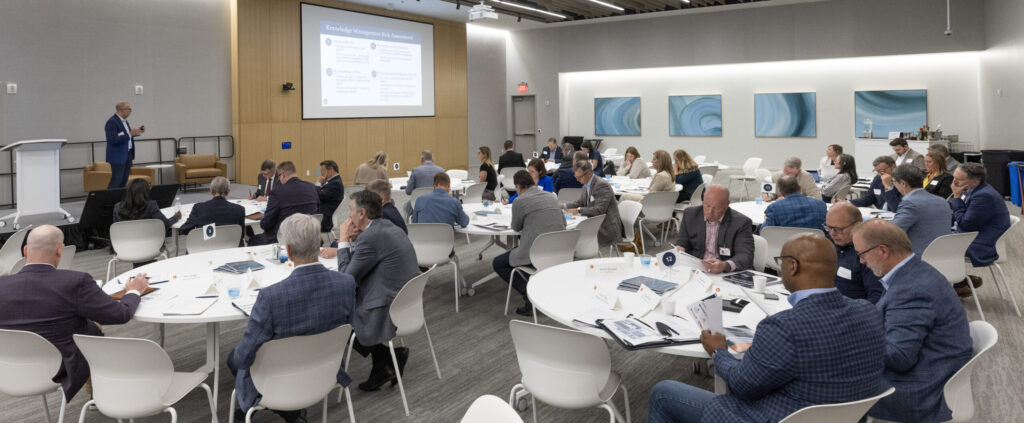On Wednesday, December 6th, at the Pinnacle Center in Hudsonville, TalentFirst was joined by expert practitioners from Corewell Health for an enriching conversation and interactive workshop puzzling toward outcomes in talent management.
In the dynamic landscape of talent acquisition, development, and retention, organizations grapple with the evolving challenges of skills gaps, rising turnover costs, and the pressing need for innovative solutions. TalentFirst hosted Enhance Onboarding & Career Pathways: Puzzling Toward Outcomes, joined by talent management experts, Charlotte Byndas and Scott Douse from Corewell Health, who led an engaging conversation exploring the impact a systems thinking and values-driven mindset has on organizational outcomes. This conversation was followed by TalentFirst’s, Carly Smyly, facilitating a workshop for participants to puzzle through onboarding and career pathways.
Keep reading for a summary of the conversation delving into the complexities of West Michigan’s talent ecosystem, exploring the impact of a systems approach to onboarding and career pathways, and uncovering deployable solutions for employers today.
Understanding the Talent Landscape
The talent landscape is undergoing a profound transformation, with 75% of employers citing a skills gap in their applicants. This gap results in an annual cost of $800,000 in lost business and productivity. And, when a skilled worker leaves, it can cost companies 60% of the person’s salary to replace them. Beyond these financial implications, the talent ecosystem faces additional population challenges, including an aging workforce, declining birth rates, declining net migration, and the disruptive influence of automation and AI.
Recognizing the high costs associated with turnover and skills gaps, talent and diversity leaders emphasize the crucial role of talent retention. According to SHRM’s research, insufficient opportunities for learning and career growth rank among the top five reasons employees leave their companies. Conversely, investing in career growth and learning opportunities can result in 12x higher job satisfaction and 4x greater organizational commitment.

A Systemic Approach to the Talent Puzzle
Employers must navigate this complex, shifting talent ecosystem. The traditional approach of segmenting attraction, retention, and development is ineffective, giving way to an integrated approach permeating the employee lifecycle — from talent attraction and hiring to retention through onboarding, development, advancement, and exit. Aligning your talent management strategy across all departments in your organization, while customizing the approach for each manager’s workforce and each employee, is crucial.
Attraction Strategies
Effective attraction begins with understanding employee personas and tailoring job postings accordingly. Whether individuals are content in their current roles, motivated by financial incentives, or aspiring for growth, diverse personas require tailored approaches. Leveraging community partnerships to hosting hiring or recruiting events in different locations with different audiences fosters connections and diversifies your talent pipeline so that you can find individuals whose values align with you organization to join your workforce.
Job Design
Continuously evaluating job designs and reshaping roles to align with community needs is essential. Assessing data on applicant flows and time to fill provides insights to the possible need for redesigning roles to be more attractive for individuals. Consider if a role is challenging to fill because of its location, hours, job scope, etc. Is it possible to change some elements of the position to allow for flexibility, variety, and adaptability while still fulfilling the critical functions? As a recruiting leader, always ask the hiring manager why the job is designed a certain way and encourage a new design for those hard to fill positions.
Skills-based Onboarding
Traditional onboarding, often laden with paperwork and administrative burdens, ought to be replaced by skills-based onboarding. This approach customizes the onboarding experience based on the skills an employee is coming in with and the resulting gap that needs to be closed. This reduces the time for new hires to become proficient in their roles. Design onboarding through a human-centric mindset, customizing the process to the individual, resulting in an intentional and more efficient onboarding experience.
Skills-based Career Pathways
Organizations ought to move beyond traditional promotions based on performance by adopting skills-based career pathways that proactively develop employees for future roles, whether they are lateral or vertical moves. This inclusive approach prioritizes transparency, providing employees with a clear understanding of development opportunities and advancement requirements. By avoiding the pitfalls of The Peter Principle, where promotions lead to roles beyond an individual’s capabilities, organizations foster a motivational environment.
It is key to tap into a variety of development opportunities from formal education to informal relationship-based methods. Development options to support career pathways span external partner trainings and degree or certification programs to internal strategies like coaching or mentorship, cross-training, stretch assignments, and apprenticeships. Structuring these options around specific competencies ensures intentional, continual progress and prepares employees for their aspirational roles.

Deployable Solutions for Today
- Intentionally schedule your next new hire’s first 30 days assigning folks from the organization to take on relevant activities and equipping them to do so. Share this plan with your new hire and all those involved.
- In your next meeting with each team member, ask them their career interests and what energizes them. Then begin to co-create a development plan.
- Help your employees explore other roles or departments within your organization by creating a culture of curiosity through networking or job shadowing. It starts with leaders intentionally spending time with folks outside their own department and empowering their direct reports to do the same.
In the ever-evolving talent landscape, a systemic approach to onboarding and career pathing emerges as a strategic imperative. By understanding the nuances of attraction, workforce design, onboarding, and career pathways, organizations can navigate talent challenges successfully, fostering a culture of growth, development, and retention.


